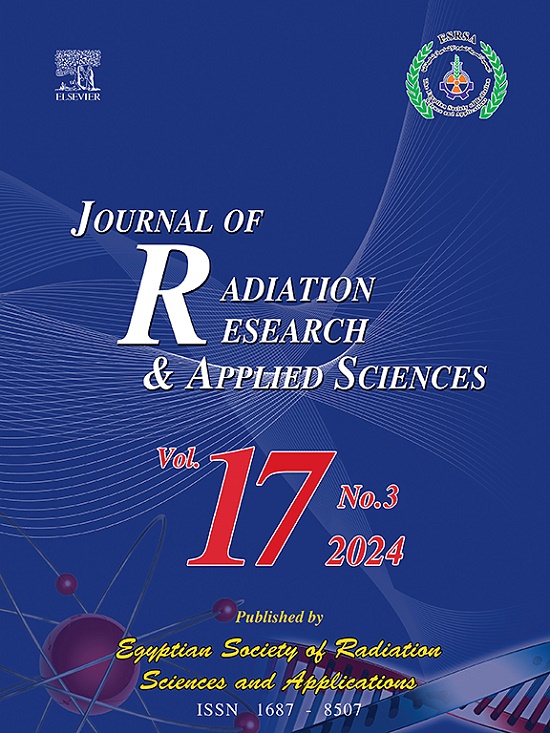Hydrothermal investigation of ionized Darcy-Forchheimer power-law hybrid nanofluid flow considering modified Fourier's law
IF 1.7
4区 综合性期刊
Q2 MULTIDISCIPLINARY SCIENCES
Journal of Radiation Research and Applied Sciences
Pub Date : 2025-03-20
DOI:10.1016/j.jrras.2025.101418
引用次数: 0
Abstract
Significance
The study of ionized Darcy-Forchheimer power-law hybrid nanofluid flow has the potential to lead to the creation of more efficient heat transfer systems. This study of modified Fourier's law can aid in understanding the non-Fourier heat conduction effects, allowing for the development of more energy-efficient systems.
Aim
The primary objective of the present investigation is to study the hydrothermal behavior of ionized Darcy-Forchheimer power-law hybrid nanofluid flow, as well as effects of modified Fourier's law on the hybrid nanofluid's heat conduction behavior. Also, effects of ionization and Power-Law Index on hydrothermal behavior of hybrid nanofluid (HNF) have been investigated and a mathematical model capable of accurately predicting the hydrothermal behavior of the hybrid nanofluid has been developed.
Assumption
Under steady-state conditions, the HNF is assumed to be incompressible, laminar, with constant thermal conductivity and negligible radiation effects. It is assumed that the nanoparticles are evenly dispersed throughout base fluid and the porous medium can be described by Darcy-Forchheimer model.
Research methodology
We develop a mathematical model that incorporates the modified Fourier's law and Darcy-Forchheimer model to explain the hydrothermal behavior of ionized Darcy-Forchheimer PLHNF flow. The non-dimensional governing equations are solved numerically by bvp4c solver in MATLAB.
Conclusion
The velocity and temperature profiles are significantly affected by various parameters, and modified Fourier's law has a significant impact on heat conduction behavior in the nanofluid. The main results are that the radial, tangential, and axial velocities diminish from shear thinning to shear thickening for power law nanofluid (PLNF) and power law hybrid nanofluid (PLHNF). Enhanced magnetic field strength controls motion of both PLNF and PLHNF. Further, amplified hall and ion slip parameters enhance the heat transfer rate from the radially stretched surface for both PLNF and PLHNF.
考虑修正傅立叶定律的电离Darcy-Forchheimer幂律混合纳米流体的热液研究
对电离的达西-福希海默幂律混合纳米流体流动的研究有可能导致更有效的传热系统的创建。修正傅立叶定律的研究有助于理解非傅立叶热传导效应,从而开发更节能的系统。目的研究电离后的幂律混合纳米流体的热液行为,以及修正傅里叶定律对混合纳米流体热传导行为的影响。研究了电离和幂律指数对混合纳米流体热液行为的影响,建立了能准确预测混合纳米流体热液行为的数学模型。在稳态条件下,假设HNF是不可压缩的层流,具有恒定的导热系数和可忽略的辐射效应。假设纳米颗粒均匀分布在基液中,多孔介质可以用Darcy-Forchheimer模型来描述。研究方法建立了一个数学模型,将改进的傅里叶定律和Darcy-Forchheimer模型结合起来,解释了电离的Darcy-Forchheimer PLHNF流的热液行为。利用MATLAB中的bvp4c求解器对无量纲控制方程进行了数值求解。结论不同参数对纳米流体的速度和温度分布有显著影响,修正傅立叶定律对纳米流体的热传导行为有显著影响。主要结果是幂律纳米流体(PLNF)和幂律混合纳米流体(PLHNF)的径向、切向和轴向速度从剪切变薄到剪切变厚逐渐减小。增强的磁场强度控制PLNF和PLHNF的运动。此外,放大的霍尔和离子滑移参数提高了PLNF和PLHNF径向拉伸表面的传热速率。
本文章由计算机程序翻译,如有差异,请以英文原文为准。
求助全文
约1分钟内获得全文
求助全文
来源期刊

Journal of Radiation Research and Applied Sciences
MULTIDISCIPLINARY SCIENCES-
自引率
5.90%
发文量
130
审稿时长
16 weeks
期刊介绍:
Journal of Radiation Research and Applied Sciences provides a high quality medium for the publication of substantial, original and scientific and technological papers on the development and applications of nuclear, radiation and isotopes in biology, medicine, drugs, biochemistry, microbiology, agriculture, entomology, food technology, chemistry, physics, solid states, engineering, environmental and applied sciences.
 求助内容:
求助内容: 应助结果提醒方式:
应助结果提醒方式:


